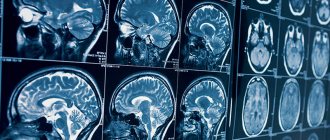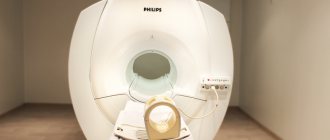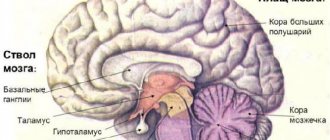MRI of the vessels of the brain and neck is prescribed to patients to identify existing pathological processes. Tomography is rightfully considered the most highly accurate type of examination. Diagnosis of soft tissue disease through other measures is very problematic.
Thus, ultrasound examination is considered a low-informative procedure, which is used for this purpose in rare cases. For example, when for one reason or another it is not possible to undergo an MRI of the vessels and arteries of the neck or brain, and it is advisable to perform a computed tomography scan only to identify tumors. In addition, CT scanning is associated with radiation exposure to the patient’s body, so scanning cannot be called completely safe and cannot be carried out without compelling reasons.
The main advantages of MRI diagnostics of brain and neck vessels
The high accuracy of MRI of brain and neck vessels is far from the only advantage of scanning. This may also include:
- absolute safety for the health of the subject;
- ease of examination;
- a small number of prohibitions and contraindications for undergoing scanning;
- a real possibility of identifying a pathological process at the very initial stage of its occurrence;
- Possibility of scanning an unlimited number of times.
As a rule, an examination of the vascular system of the brain is carried out together with an MRI of the vessels and arteries of the neck.
Carrying out two types of diagnostics simultaneously is determined by the fact that normal blood flow in the brain can only be ensured if there are no disturbances in blood circulation in the neck. For example, improper blood circulation as a result of mechanical injury in the neck area in most cases leads to oxygen starvation of the brain, which can cause the death of the victim. This leads to the logical conclusion that it is not advisable to conduct exclusively magnetic resonance imaging of brain vessels.
The scan allows specialists to draw conclusions based on 3D images of blood supply in a particular part of the brain.
MRI of cerebral vessels is a unique diagnostic method that detects diseases of the veins and arteries, so no type of examination can be compared with tomography due to its significantly low information content.
Due to layer-by-layer scanning and high-quality images, the likelihood of error during diagnosis is practically reduced to zero.
Does MRI show the condition of blood vessels?
Using MRI diagnostics, it is possible to examine almost all structures in the human body. But patients often have the question “Are the vessels visible on MRI?” With a normal scan, veins and arteries are not visible. The study can be performed in angio mode. The additional use of gadolinium drugs makes it possible to enhance the contrast of images and examine small vessels in detail.
The doctor examines the structure of the bloodstream in the resulting images and pays attention to any deviations from the norm. Based on the results of MRI of cerebral vessels, the following can be identified:
- consequences of hemorrhages;
- areas of occlusion (blockage);
- signs of atherosclerosis;
- areas of pathological narrowing (stenosis) or expansion (aneurysm);
- inflammatory changes;
- blood clots;
- dissection of arterial walls, etc.
Foci (2) of ischemic stroke in the cortical regions of the right hemisphere on an MRI scan
Indications for MRI of head and neck vessels
As a rule, such an examination is not prescribed by specialists for no apparent reason. Reasons for prescribing a scan may include:
- ischemic disease;
- very frequent headaches;
- the appearance of dizziness;
- sensation of ringing and noise in the ears;
- vegetative-vascular dystonia.
After the scan, the doctor evaluates the resulting images, where it is possible to clearly visualize the blood supply to various areas of the brain and neck.
What does the scan reveal?
It is advisable to conduct MRI of the vessels and arteries of the neck to identify many diseases and pathological processes, which include:
- cerebrovascular accident due to the presence of atherosclerotic plaques on the inner walls of blood vessels;
- received injuries to the head and neck;
- brain infections of any etiology;
- life-threatening conditions due to brain damage (for example, cerebral infarction);
- any neoplasms;
- pathological structure of the vascular system of the brain;
- multiple sclerosis.
Contraindications for examination
Despite the fact that MRI of the head and neck vessels is an absolutely safe diagnosis, there are still some contraindications for its use. If we look at it as a whole, they are not at all different from those contraindications that apply to scanning other parts of the body.
First of all, MRI of cerebral vessels is unacceptable for people with metal objects in their body. Any implants, stimulators, prostheses act as contraindications. The exception is products made of titanium. After the doctor is aware of the presence or absence of such objects in the body, the patient will be allowed to undergo the examination or will be refused. In this case, the patient must provide the specialist with appropriate documentary evidence of his words. The type of material from which a particular implant is made is recorded in a special certificate issued after the surgical intervention.
Another contraindication to MRI of the vessels of the head and neck is scanning using contrast for women carrying a child. The chemical substance, despite its relative safety for an adult, can cause irreparable harm to a developing fetus, which is why such a ban is due.
The use of contrast is unacceptable regardless of the duration of pregnancy, as well as during the lactation period. At the same time, MRI of the vessels and arteries of the neck without contrast enhancement is quite acceptable for pregnant women in the 2nd and 3rd trimesters, when the fetus has developed all vital organs and systems.
Limitations for MRI of brain and neck vessels
It is not always possible to conduct tomography for people with mental illness, patients with uncontrolled movements of the limbs, as well as people with a fear of being in a confined space. Often, scanning of such patients is carried out in a state of medicated sleep, since otherwise it is impossible to carry out a diagnosis.
It is especially difficult to perform MRI of cerebral vessels in patients on mechanical ventilation. Not every medical institution has specialists who can take on such responsibility.
Very often, tomography is performed under anesthesia and in young children. It is very difficult for children to remain immobilized throughout the entire examination period, and under anesthesia, the scanning is very calm for both them and the doctors. Another advantage of using anesthesia is that young patients will not experience any stress and will not have negative memories.
How is an MRI of the brain performed?
If an MRI of the brain is being performed without contrast, you will immediately be asked to go into the office and lie down inside the machine. If contrast is required, you will first be given gadolinium intravenously.
You must lie still during the examination to ensure clear images. The diagnostic table moves, while the device takes a series of images. The doctor is in the next room and communicates with the patient through a microphone.
How long does a brain MRI take? On average, the study lasts 45 minutes, the total time depends on the need to use contrast and perform a functional MRI.
Preparation for MRI of brain and neck vessels
Many patients before undergoing MRI of cerebral vessels are worried that they will have to comply with some strict restrictions before scanning. Such speculation is completely unfounded. There is no need to carry out any preparatory measures on the eve of the diagnosis, which is a huge advantage of magnetic resonance imaging. As discussed above, the most important condition is that the patient should not have any metal objects in his body, and it is also unacceptable to undergo scanning in clothes that have rivets, buttons, zippers and other metal parts. It is recommended to change your clothes to looser or hospital clothes.
Patients who have been scheduled to undergo an MRI of cerebral vessels using contrast should not eat any food on the day of the examination. The scanning itself takes place very quickly (usually it does not take more than 15 minutes), so no unpleasant sensations should arise during this time.
CT or MRI?
Both studies work approximately the same way and create highly informative images with layer-by-layer sections of a certain area of the body, three-dimensional images. But during a CT scan, X-rays are used, and during an MRI, a strong magnetic field is used.
Computed tomography better visualizes the bones of the skull and vertebrae, and intracranial hemorrhages. In addition, it is cheaper and simpler than MRI, so it is more preferable for quickly examining people who have suffered a traumatic brain injury.
MRI images clearly show ligaments and tendons, nerve fibers, and tissue of the brain and spinal cord. This study is better suited than CT for diagnosing benign and malignant neoplasms of the nervous system.
Come to an appointment with medical specialists at the Medica24 International Clinic, they will assess your situation and tell you whether you need to do an MRI of the head and cerebral vessels, or undergo other diagnostic procedures.
We will call you back
Message sent!
expect a call, we will contact you shortly
How is MRI of the vessels of the brain and neck performed?
Diagnosis is carried out using a special device - a magnetic resonance imaging scanner, which looks like a large tunnel from the outside. Before the scan begins, the patient is explained how to behave correctly inside the device, namely:
- It is prohibited to bring any gadgets with you;
- it is unacceptable to make any, even the most insignificant movements;
- You cannot make movements with your mouth (for example, try to speak).
Of course, in exceptional cases, when the patient feels significant changes in well-being during an MRI of the vessels and arteries of the neck or brain (which happens extremely rarely and is most likely caused by fear of undergoing diagnostics), he will always be able to contact the medical staff using a speaker and report changes in your health. If there are compelling reasons, the doctor may decide to interrupt the procedure.
The patient is also informed that there is no need to be afraid of the characteristic sounds of a working tomograph - this is a completely natural phenomenon. The doctor will ask how you are feeling and suggest taking sedatives if necessary.
If MRI of brain vessels needs to be performed using contrast, the doctor will definitely ask about the presence of allergic manifestations to medications.
The scanning takes place without the use of radiation exposure, which means it is completely harmless to the patient. Due to the fairly short examination time, patients in most cases tolerate it well, because the likelihood of panic attacks during an MRI of the vessels and arteries of the neck or brain is minimized.
Indications for general anesthesia for MRI
Intravenous or inhalational sedation is only necessary for patients who are unable to hold their body still for long periods of time. Main indications for general anesthesia:
- Claustrophobia is the fear of closed spaces. Such patients, while inside the device, experience panic, which negatively affects their health and makes MRI diagnostics impossible.
- Mental disorders accompanied by unpredictability of behavior and high excitability.
- Uncontrollable involuntary head movements (swaying, shaking, tics).
- Epilepsy and other types of convulsive readiness and seizures - anesthesia is given only intravenously due to the risk of provoking a seizure attack.
- Early childhood. Small children cannot lie still for a long time in an MRI scanner, so light mask anesthesia is indicated for them.
- Severe pain syndrome, in which prolonged stay in one position causes discomfort, cramps, pain and spasms.
Decoding the received data
As soon as the examination is completed, the patient will be able to leave the office to await the conclusion. Based on the images obtained, the radiologist will make a diagnosis and write a report. It can be issued both in paper and electronic form on any digital medium. The patient must show the obtained images and the report to the doctor who has been prescribed a referral for magnetic resonance imaging.
In the event that the tomography was carried out on your own initiative, you need to contact the specialist who is involved in the treatment of the identified pathology. It is important to remember that the earlier the correct treatment is started, the higher the likelihood that it will be successful and will not take long.
Potential Risks
Carrying out magnetic resonance imaging does not involve any risks for the patient. Due to the fact that the subject’s body is securely fixed with special straps, throughout the entire scanning period the likelihood of any injury is reduced to zero.
However, the possibility of unpleasant sensations due to being inside the tomograph cannot be completely excluded. The patient may experience increased heart rate, dizziness, and a feeling of tightness in the sternum, which has a psychosomatic cause. Therefore, you should not ignore the doctor’s suggestion to take sedatives before starting the examination.
Benefits of a head MRI procedure
Magnetic resonance imaging is the main method for studying the brain due to the lack of negative effects on the human body. Many alternative research options involve radiation exposure (x-rays), so they should be treated with greater caution and require a referral from a doctor
Now many clinics in Moscow, both private and public, offer this service. However, the fact on which equipment the MR examination was performed is of great importance. The multidisciplinary CELT clinic has a modern high-field MR tomograph (1.5 Tesla). Such characteristics make it possible to identify any pathologies. Research using low-field equipment may be useless for the attending physician due to its low resolution.
Magnetic resonance imaging is one of the few methods for studying the head and brain that combines two important qualities: safety, which we have already mentioned above, and efficiency. The images obtained as a result of an MRI of the head are clearer and more detailed, which allows doctors to obtain complete information about the patient’s health status.











